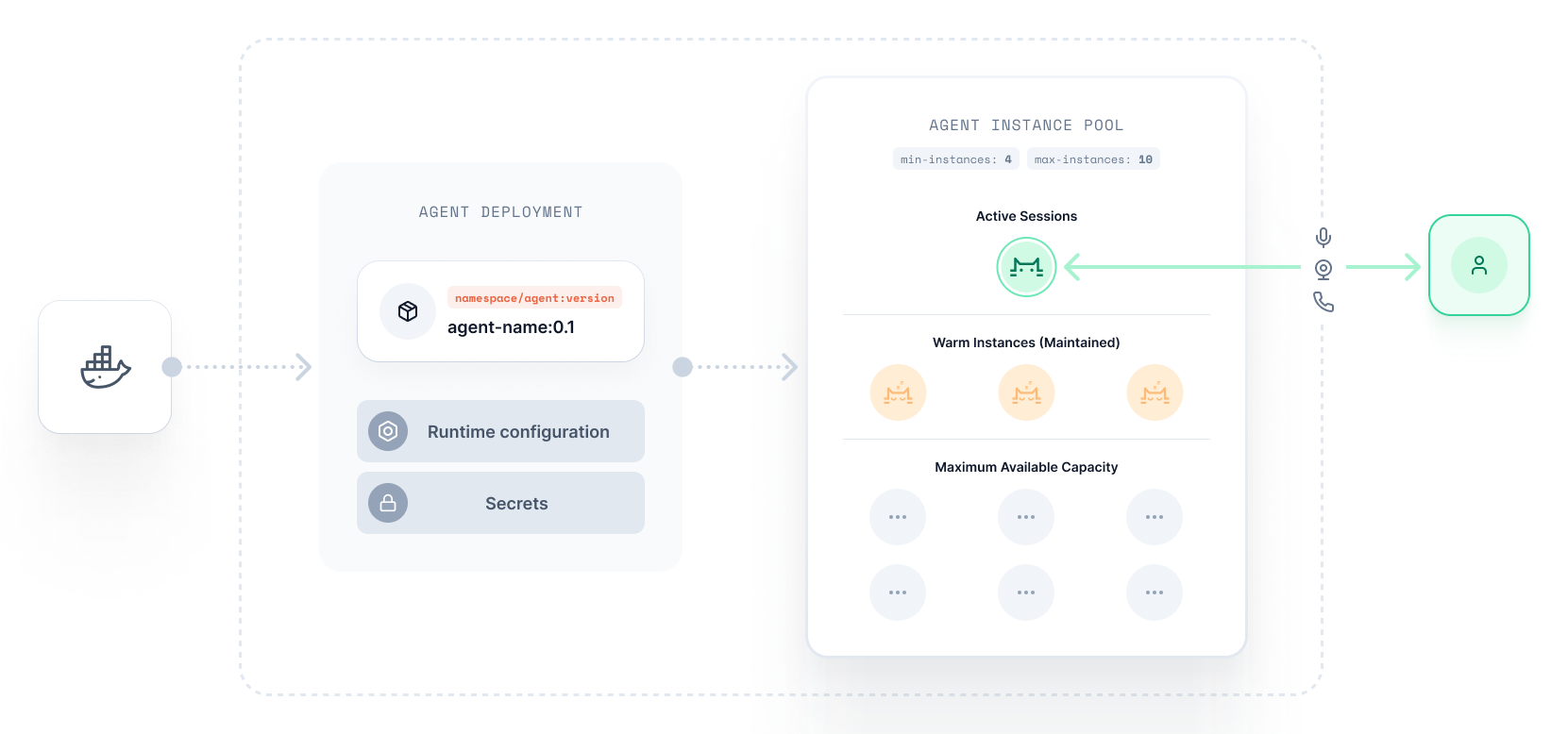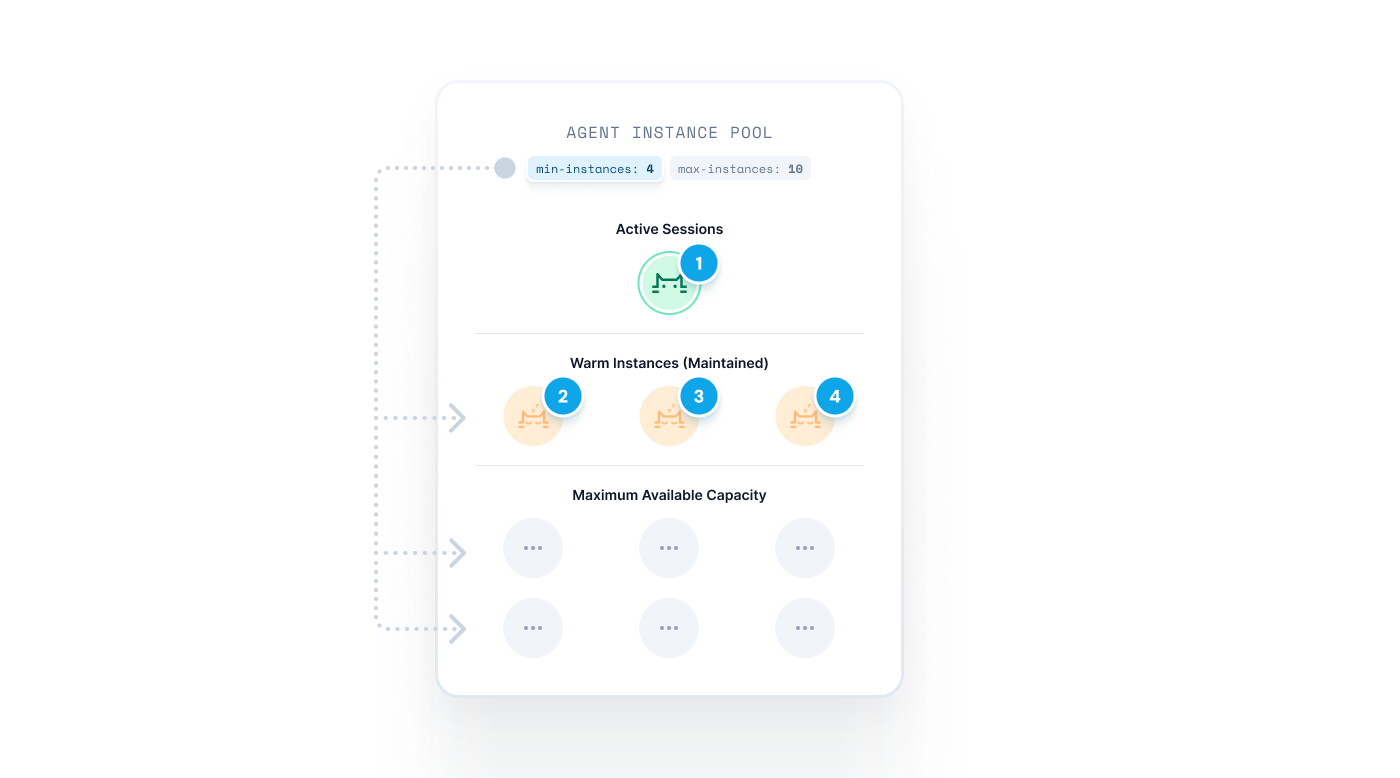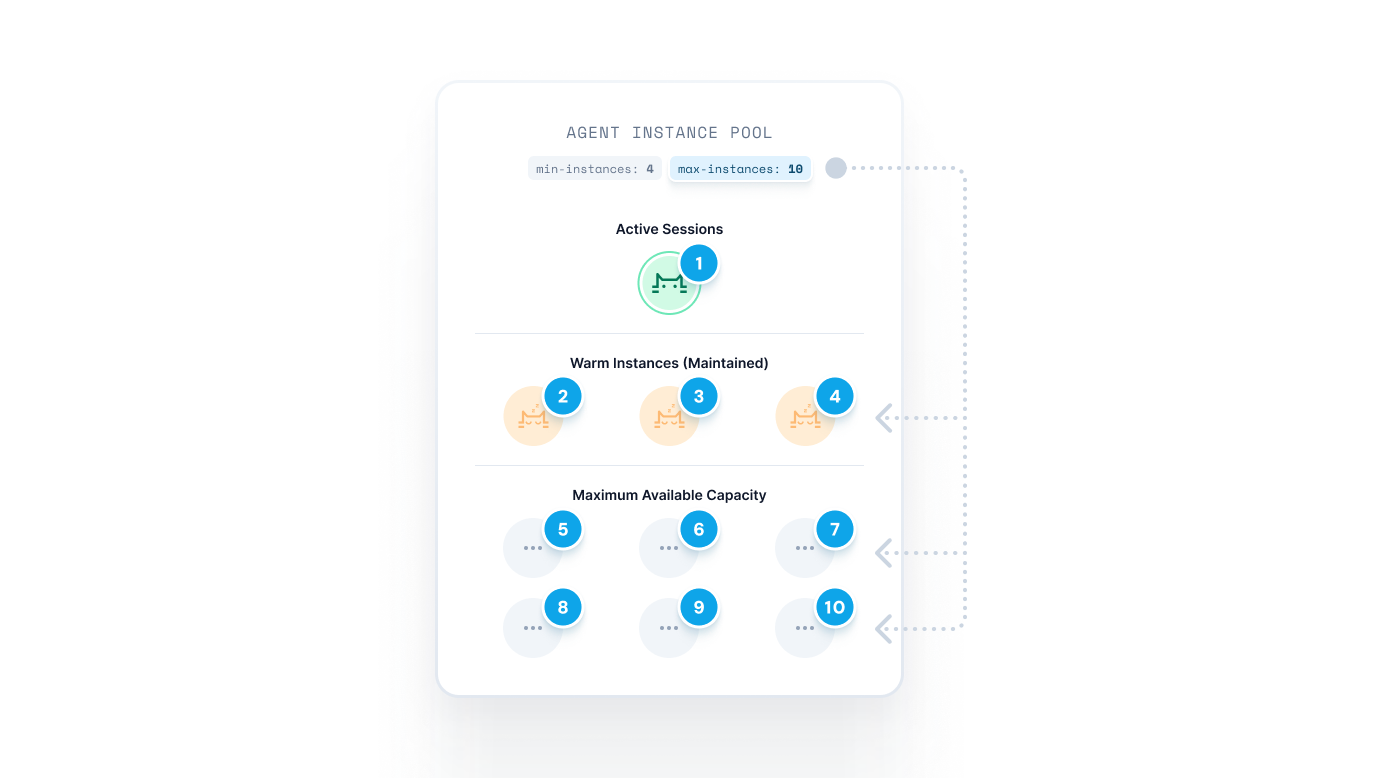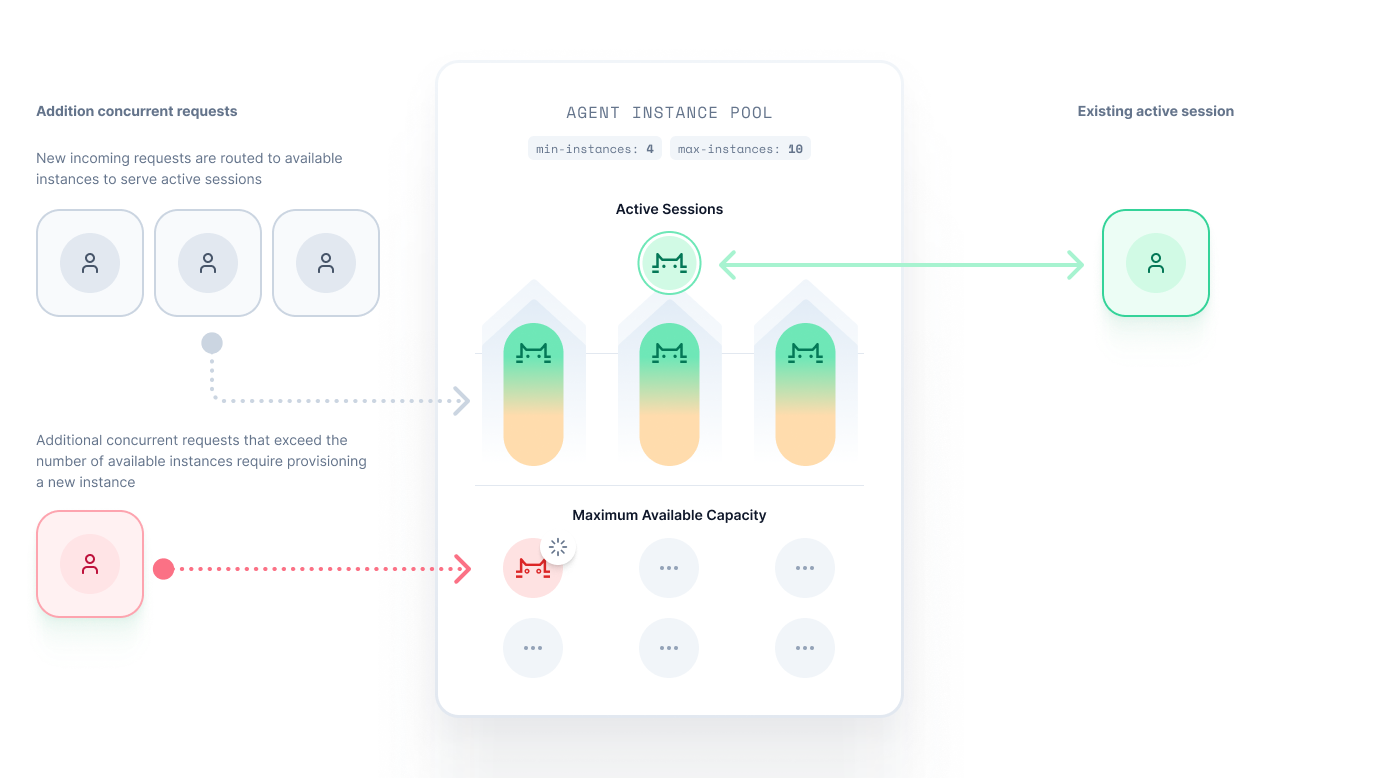Agents
Scaling
Production-ready agent deployment and scaling strategies
Agentic applications demand near-instant agent availability to maintain user engagement and responsiveness. Pipecat Cloud manages the complexity of scaling these agent deployments in production environments, providing granular controls for compute resources and cost optimization.
 Developers can configure the upper and lower limit of a deployment’s instance pool, providing a cost-effective way to handle varying loads.
Developers can configure the upper and lower limit of a deployment’s instance pool, providing a cost-effective way to handle varying loads.
 Developers specify a
Developers specify a
 Deployments can optionally be made with a
Deployments can optionally be made with a
 Pipecat Cloud aims to mitigate cold starts as much as possible through auto-scaling.
Pipecat Cloud aims to mitigate cold starts as much as possible through auto-scaling.
When your traffic increases and you have active sessions running, our system automatically:
Please note that changing your scaling parameters will not disrupt any active sessions.
If you reduce your max instance count below the number of currently active sessions, you will still be billed for the duration of those sessions.
Core concepts
Instances
An instance represents a single unit of compute that runs your agent. Instance costs are determined by:- Active session runtime duration
- Warm instance maintenance time
- The compute profile specified in your deployment
Instance pool
Making a deployment to Pipecat Cloud creates a managed pool of agent instances that:- Routes requests to available agent instances
- Scales based on demand within configured limits
- Maintains optimal performance through auto-scaling

Minimum agents
min-agents
- Maintains specified number of warm agent instances to serve incoming requests
- Immediately ready to become active, reducing cold starts
- Defaults to
0if unspecified

Minimum number of agent instances maintained in a pool at all times.
min-agents configuration to determines the number of agent instances that should be kept warm in their deployment pool. A warm instance is kept running and can immediately be used to serve an active session.
Maintaining a minimum number of agent instances is important to keep agent start times fast and reduce cold starts.
Setting
--min-agents to 1 or greater will incur charges even when the agent
is not in use.Maximum agents
max-agents
- Sets hard limit on concurrent sessions
- Acts as a cost control / load mechanism
- Returns HTTP 429 when pool capacity is reached

Maximum agents is the hard limit on the number of agents in your pool.
During beta, each deployment made to Pipecat Cloud has a maximum allowed pool
size of 50. Please contact us at help@daily.co or via
Discord if you require more capacity.
max-agents configuration that limits the number of agent instances that your pool can contain.
This exists as a cost control measure, allowing developers to limit the total number of active sessions that can be run at any one time.
The maximum instance count is a hard limit, meaning requests made to a pool that is at capacity will receive a 429 response. See starting sessions for more information for how to handle this in your application code.
Agent lifecycle
1
Pool Initialization
- Provisions the minimum number of warm agent instances based on
min-agentsconfiguration (defaults to0) - Listens for session requests to route to available agent instances
2
Session Assignment
- ✅ If a warm instance is available, the session will be assigned to that instance
- ⏳ If no warm agent instances are available, and your pool is not at capacity, a new instance will be provisioned to handle the request (e.g a cold-start)
- ❌ If your pool is at capacity, your application will receive a
429response from the start request
3
Auto-scaling
- The Pipecat Cloud auto-scaler determines if additional warm agent instances should be created to support further requests.
- Once a session concludes, agent instances are either returned to the pool to serve another session or discarded
Your are billed for warm agent instances, even if they are not handling
active sessions. Developers should consider their deployment strategy when
cost optimizing, adjusting the minimum and maximum instance count accordingly.
See current pricing for details.
Cold-starts
A cold start may occur when an active session request is made and no warm agent instances are available in the pool to handle it. In this case, Pipecat Cloud will provision a new instance to handle the request. Cold starts require additional time to provision the instance and load the agent instances, which may result in a delay for the user. To minimize cold starts, you can configure your pool to maintain a minimum number of warm agent instances at all times.
How long does a cold start take?
How long does a cold start take?
The exact duration of a cold start depends on multiple factors, such as the size of your agent image and the complexity of your agent. In general, cold starts take around 10 seconds. Once you have a running instance of a deployed image, new sessions start immediately with no cold start delay.For developers, especially during test and development, using scale-to-zero with cold starts is a good place to start as it saves money. Once you understand your utilization pattern, you can build a strategy around optimizing start times by maintaining warm agent instances.
Mitigation strategies
Mitigation strategies
To avoid cold starts, you can:
- Adjust the number of warm agent instances (
min-agents) in your pool to ensure that there are always agent instances available to handle requests. - Adjust your maximum instance count (
max-agents) and issue capacity notifications in your application.
Scale-to-zero
For some deployments, using a minimum instance count of 0 is preferable (e.g. while in development.) Since you are only charged for warm agents instances and active sessions, this can be a cost-effective way to manage deployments where fast start times are not required. When the minimum instance count is set to 0, the pool will scale down to 0 agent instances when there are no active sessions. Idle agent instances are maintained for 5 minutes before being terminated.Scale-to-zero is not recommended for production deployments where immediate
response is required.
Auto-scaling
Pipecat Cloud performs auto-scaling by default on all deployments. Auto-scaling is accomplished through the following mechanisms:- Scaling up based on request velocity
- Maintaining efficiency within max-agents limit
- Scaling down to min-agents (or zero) during low usage
- Supporting burst workloads automatically
Auto-Scaling Buffer
Pipecat Cloud maintains a free auto-scaling buffer in addition to your
paid reserved agent instances. This saves you from over-provisioning warm
agent instances while still ensuring fast response times during traffic
increases.
- Proactively provisions additional idle agent instances based on your current usage patterns
- Provides these buffer agent instances at no additional cost to you
- Ensures you can continue handling traffic spikes even when all your paid warm agents are in use
- The system is already spinning up additional buffer agent instances in the background
- These buffer agent instances become available within ~10 seconds
- You can continue calling the
/startendpoint without worrying about configuring additional capacity
- You can set a lower
min-agentsvalue than your peak traffic requirements - You’ll still avoid cold starts in most scenarios
- You get better cost efficiency without sacrificing performance
min-agents values is for extremely rapid traffic spikes (tens or hundreds of calls per second) where the buffer can’t be provisioned fast enough.
Scaling Philosophy
Our scaling system is designed to minimize the need for manual capacity planning. Here’s how we recommend thinking about scaling:-
Start simple: We encourage you to set
min-agentsto 0 initially and test how the system performs for your specific use case. Many applications work well without any pre-warmed agent instances. - Optimize as needed: We work hard to make cold starts rare and as fast as possible so that, for many applications, you don’t have to worry about warm instances at all.
-
Tune for traffic patterns: If you have spiky workloads with bursty traffic patterns, setting an appropriate
min-agentsvalue can help prevent cold starts during critical periods. Consider scheduling highermin-agentsvalues only during your peak usage hours.
Updating scaling configuration
You can update your deployment’s configuration at any time via the CLI or Pipecat Cloud Dashboard.Capacity Planning
Effective capacity planning is crucial for production deployments to ensure your agents respond immediately. Pipecat Cloud auto-scales your agents. For most cases, the only action you need to take is to set the--min-agents parameter to 1. However, if your application experiences fluctuations in traffic, you may need to plan for additional warm capacity to ensure your agents are always ready to respond immediately.
Capacity Planning Guide
See our guide for calculating reserved agents, understanding warm capacity,
and implementing scaling strategies for production.
Usage summary
Pipecat Cloud bills based on:- Active session minutes
- Reserved session minutes
/start endpoint (or CLI or SDK equivalent). The active session ends when your pipeline shuts down.
Reserved session minutes are the time your warm agent instances are kept running, even if they are not handling active sessions. When active sessions start, the auto-scaler may provision further warm agent instances to support the next incoming request. Reserved session minutes are optional and controlled by setting --min-agents in your deployment configuration.
Both active and reserved session minutes are rounded up to the nearest minute.

